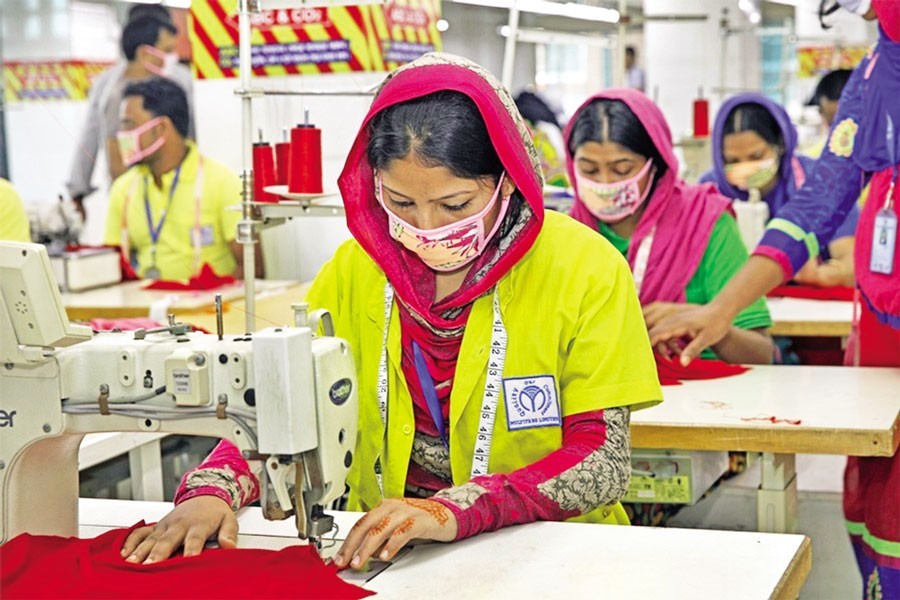Female workers, despite their larger representation in local garment factories, are paid lower than their male counterparts, according to a latest report of the International Labour Organisation (ILO).
The gender pay gap (difference between male and female hourly earnings as a percentage of male earnings) was as high as 41 per cent for Pakistan and 22 per cent for Bangladesh, it showed.
In contrast, Cambodia, Myanmar and Indonesia have a very small gender pay gap in their garment sector, while women earn five per cent more than men in Indonesia, on an hourly basis.
The percentage rate is 33 and 9.0 for Sri Lanka and Vietnam respectively.
The report - "Employment, wages and productivity in the Asian garment sector: Taking stock of recent trends" - was published on June 24.
"Although women represent a large share of garment workers in Asia, gender pay gaps persist, and are particularly elevated in the countries, where there are broader systematic labour market challenges for women, like Pakistan and Bangladesh," read the ILO report.
It showed that Asia remains the garment factory of the world. Yet the sector faces an array of challenges, including rising labour costs, production and process automation, 'reshoring' and 'nearshoring', many of which have been accelerated by the COVID-19 pandemic.
The report reviewed employment, wages and labour productivity in the Asian garment sector over the 2010-19 period.
It also highlighted how the industry still accounts for 55 per cent of global textiles and clothing exports as well as employs some 60 million workers.
According to the digital platform Mapped in Bangladesh (MiB), which so far mapped 3,880 export-oriented garment factories in the country, the ratio of male and female garment workers in export-oriented RMG factories now stands at 42.3:57.7.
A recent study by SANEM also showed that median monthly wage of female garment workers was Tk 12,000 against Tk 13,000 of their male counterparts in March 2022.
The wage was Tk 8,000 for women and Tk 10,000 for men in May 2020, it revealed, showing the similar trend even after the pandemic.
It further showed that wages increased, as workers did more overtime, as their wages were not sufficient to meet their expenditure. Even the additional earnings also failed to meet their basic needs.
According to the ILO report, the gender segregation by occupation is such that the RMG sector is 'female dominated at the bottom and male dominated at the top' in a highly competitive and stressful environment, where limited monitoring and accountability can result in gender-based violence.
"While in many countries the sector has seen growth in both wages and productivity, the relationship is not always clear and simple, as the government policies and external forces can play a big part in shaping outcomes for workers and businesses," noted David Williams, manager of the ILO's Decent Work in Garment Supply Chains Asia programme .
The report highlighted how the sector's evolution is following different trajectories across the region.
While economic diversification and upgradation have reduced its importance in the countries like China, Thailand and the Philippines, it remains the key economic driver in the nations like Cambodia and Bangladesh.
For decades, the sector has relied heavily on low labour costs to secure global market advantages. Real wages in the sector have increased in most countries, although working conditions remain challenging in general, including long and intense working hours, poor occupational safety and health as well as violations of fundamental rights at work.
Data in the report reveals a positive association between growth in labour productivity and wages in the sector, suggesting that investment in labour productivity may play an important role in helping elevate workers' payment.
When asked, Mohammad Hatem, executive president of the Bangladesh Knitwear Manufacturers and Exporters Association (BKMEA), said there is no wage discrimination in the country's garment industry.
Workers get wages according to their grades and they receive on-job trainings, as majority of them join the workplace at entry level.
"If a worker, irrespective of male and female, can't enhance skill or production capacity, how he or she can be offered high wages," he raised question.
Upper grades are achieved through showing quality or skills, and wages in different grades or even in the same grade are increased from time to time.
"Otherwise, workers left job," he added.
When asked, Nazma Akter, president of the Sommilito Garment Workers Federation, said the structure of the sector is responsible (for the situation), which largely depends on cheap labour.
Besides, women mostly do production floor job, while men do supervisory works and upper grade jobs.
Low wage with long working hours resulted in many health issues for women. As a result, they left the industry before they reached their 40, she alleged.
Both RMG owners and the government should focus on the issue, as the industry is now facing acute worker shortage.
Living wage should be ensured for workers and measures should be taken for their skill development, she noted.


